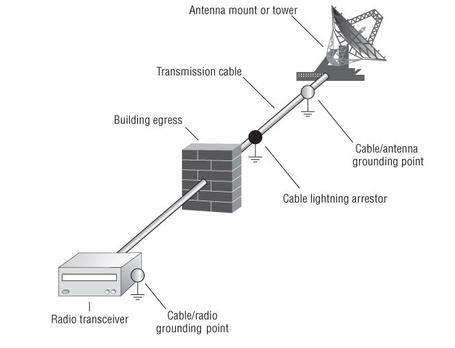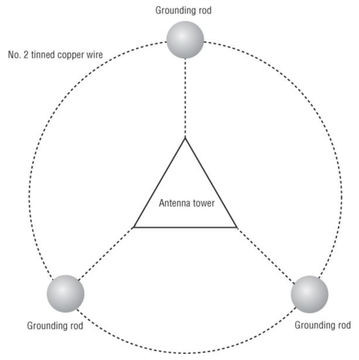Lightning arrestors and grounding rods/wires
. . . .
Lightning arrestors
- The purpose of a lightning arrestor is to redirect (shunt) transient currents caused by nearby lightning strikes or ambient static away from your electronic equipment and into the ground.
- Lightning arrestors are used to protect electronic equipment from the sudden surge of power that a nearby lightning strike or static buildup can cause.
- Lightning arrestors are not capable of protecting against a direct lightning strike.
- Lightning arrestors can typically protect against surges of up to 5,000 amperes at up to 50 volts.
- The IEEE specifies that lightning arrestors should be capable of redirecting the transient current in less than 8 microseconds.
- Most lightning arrestors are capable of doing it in less than 2 microseconds.
- The lightning arrestor is installed between the transceiver and the antenna.
- Any devices that are installed between the lightning arrestor and the antenna will not be protected by the lightning arrestor.
- Therefore, the lightning arrestor is typically placed closer to the antenna, with all other communications devices (amplifiers, attenuators, etc.) installed between the lightning arrestor and the transceiver.
- Figure 4.22 shows a properly grounded radio, cabling, and antenna.
- After a lightning arrestor has performed its job by protecting the equipment from an electrical surge, it will have to be replaced, or it may have a replaceable gas discharge tube (like a fuse).
- Most installations place the lightning arrestor at the egress to the building. Cable grounding kits can be installed near the antenna and at every 100 feet.
Ground rods and wires
- When lightning strikes an object, it is looking for the path of least resistance, or more specifically, the path of least impedance.
- A grounding system, which is made up of a grounding rod and wires, provides a low-impedance path to the ground.
- This low-impedance path is installed to encourage the lightning to travel through it instead of through your expensive electronic equipment.
- Grounding rods and wires are also used to create what is referred to as a common ground.
- One way of creating a common ground is to drive a copper rod into the ground and connect your electrical and electronic equipment to this rod by using wires or straps (grounding wires).
- The grounding rod should be at least 6 feet long and should be fully driven into the ground, leaving enough of the rod accessible to attach the ground wires to it.
- By creating a common ground, you have created a path of least impedance for all of your equipment should lightning cause an electrical surge.
- On tower structures, a grounding rod should be placed off of each leg with a No. 2 tinned copper wire.
- These connections should be exothermically welded to the tower legs.
- A No. 2 tinned copper wire should also form a ring around the grounding rods.
- The dashed lines are No. 2 tinned copper wire and the circles are grounding rods.
- Ice bridges and building grounds should also be bonded to this ring to provide equal grounding potentials.
Reference:
Coleman, David D.,Westcott, David A. CWNA: Certified Wireless Network Administrator Official Study Guide: Exam CWNA-106 Wiley.
Coleman, David D.,Westcott, David A. CWNA: Certified Wireless Network Administrator Official Study Guide: Exam CWNA-106 Wiley.
|
|


